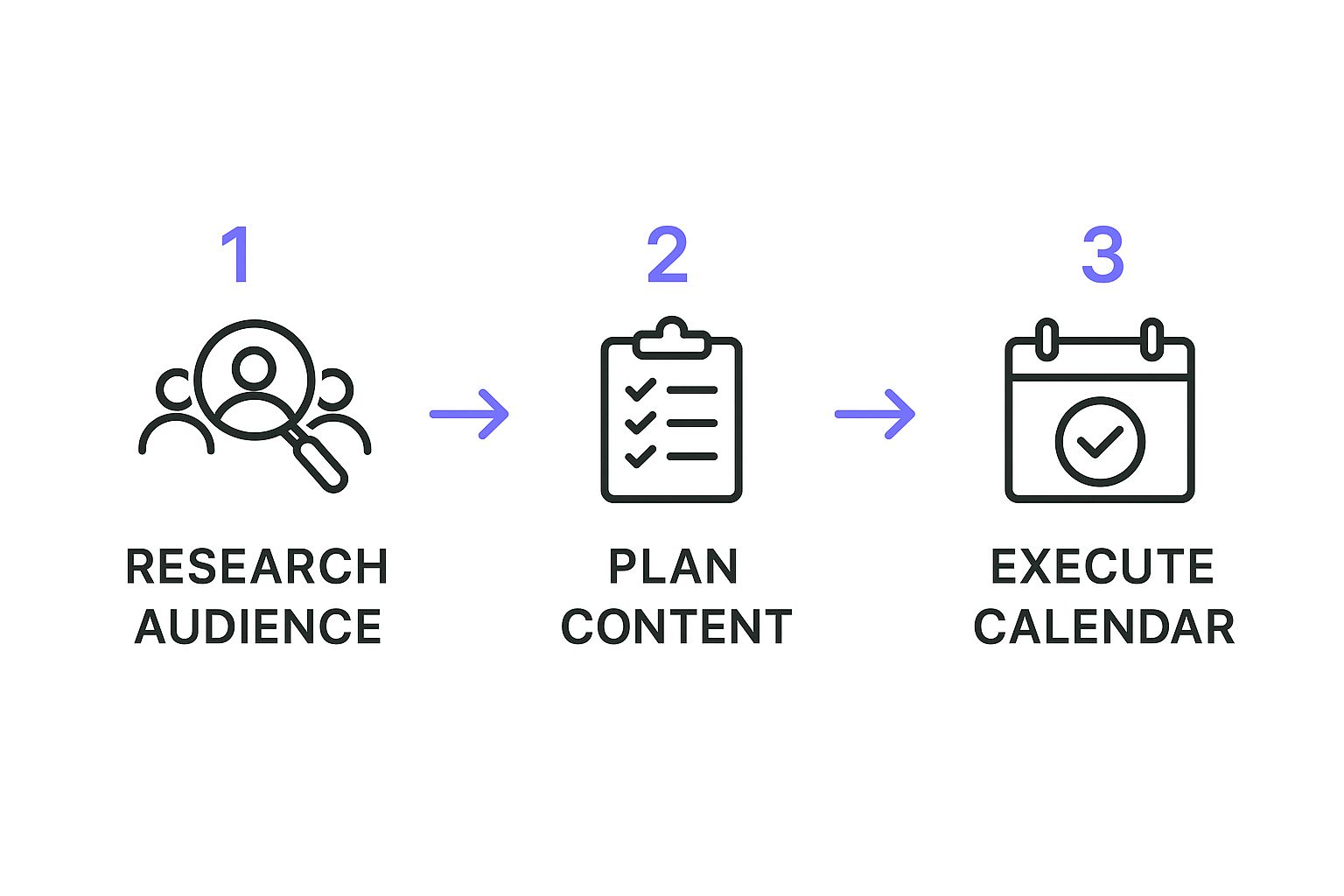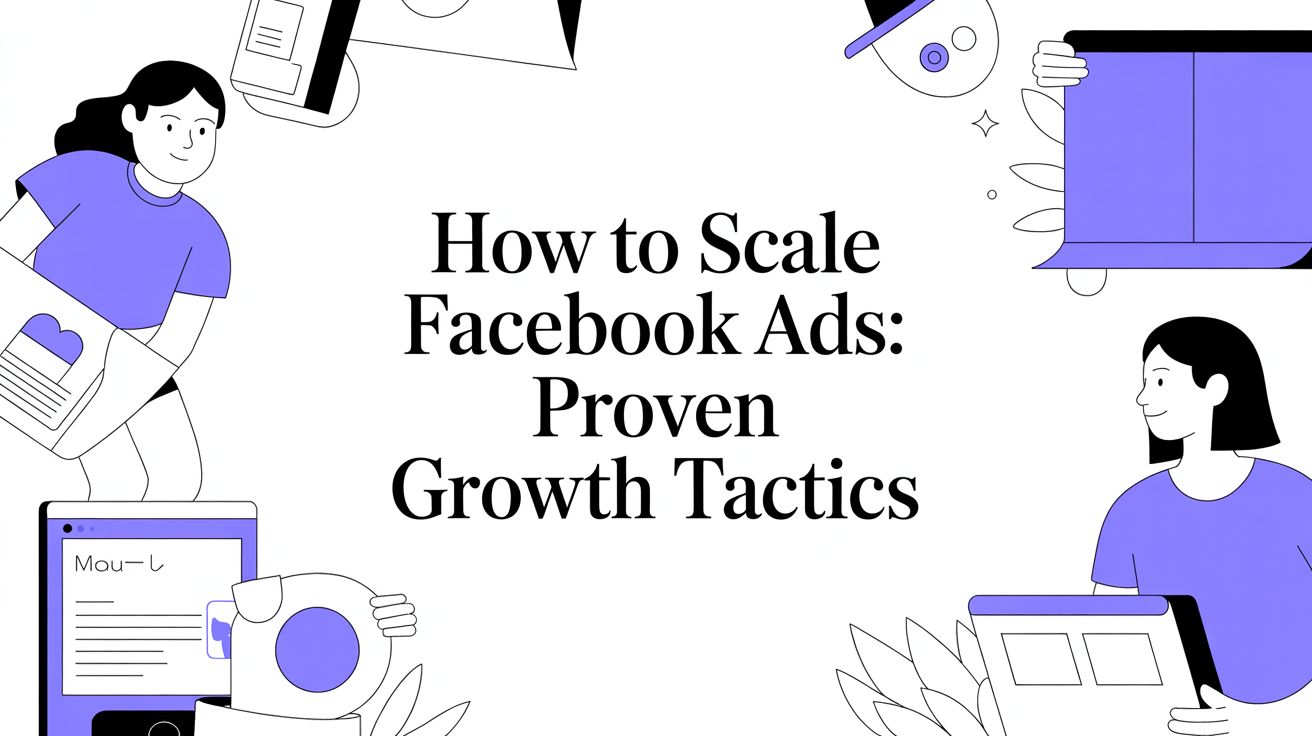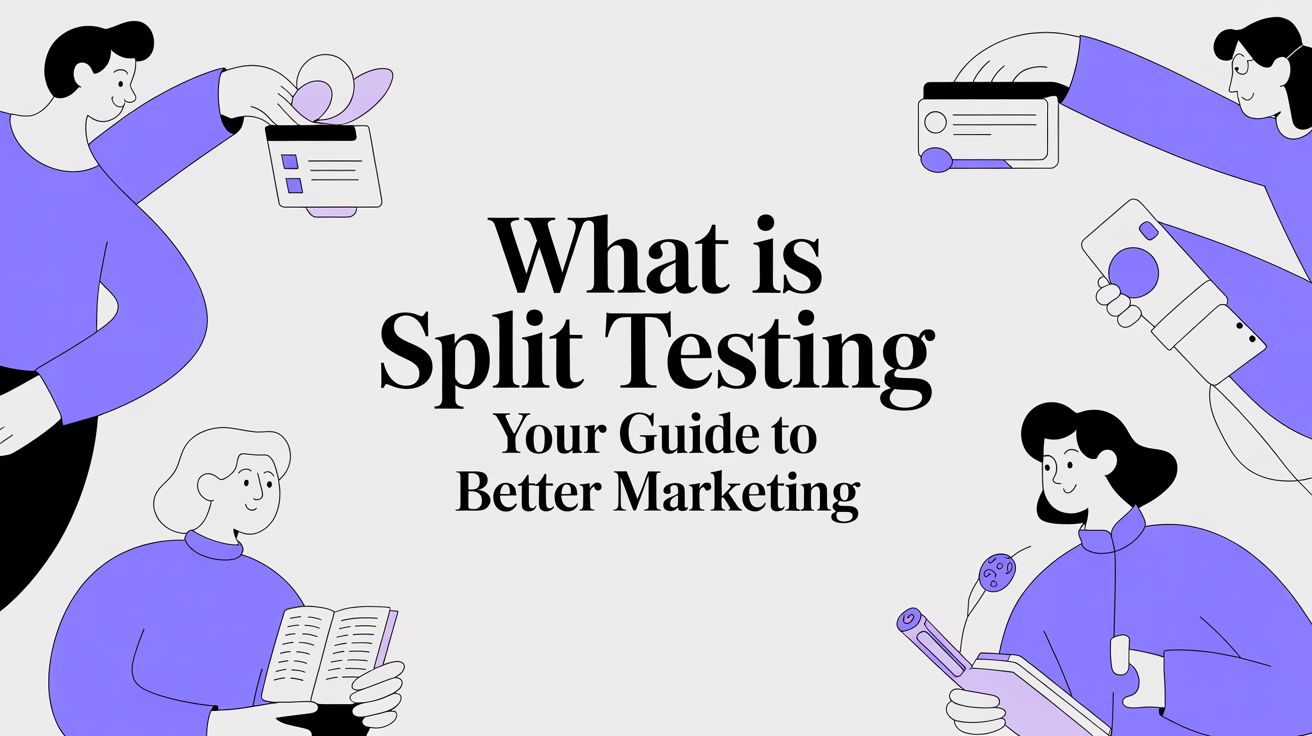So, what exactly is content marketing for a small business? Think of it less as direct selling and more as sharing what you know. It's the art of creating and distributing genuinely useful online material—like blog posts, how-to videos, or insightful social media updates—to attract and hold the attention of your ideal customer. The real goal is to build trust by proving you're an expert in your field.
Why Content Marketing Is a Game-Changer for Small Businesses

It's time to move beyond the old playbook of aggressive sales pitches and expensive ad campaigns. Small business content marketing lets you become the most helpful, go-to expert in your niche. It’s a powerful strategy that levels the playing field, allowing you to compete with bigger players by simply sharing your unique knowledge.
Imagine traditional advertising is like shouting with a megaphone on a crowded street. You might get a few people to turn their heads, but most will just walk on by. Content marketing, however, is like hosting a workshop where you offer fantastic, free advice. The people who genuinely need your help will show up, listen, and remember you when it's time to buy.
Build Authority and Trust
When you consistently put out useful information that actually solves your customers' problems, you're not just a business anymore—you're an authority. This creates a deep-seated trust that you just can't buy. Once customers see you as a credible source, they're much more likely to choose you over the competition. It’s about turning your expertise into your best marketing asset.
The concept is beautifully simple: help your audience win, and they'll help your business grow. This builds a relationship based on value, not just a one-off transaction.
A great way to boost this authority is to pair your content with smart public relations. Getting your business mentioned in the media can really amplify your message. You can find some great strategies in guides covering PR for small business.
A Sustainable Growth Engine
Here’s the best part. Unlike paid ads that disappear the second you stop funding them, your content keeps working for you 24/7. A single, well-written blog post or a helpful video can keep drawing in new customers from search engines for months, or even years, after you hit "publish." This creates a reliable, long-term stream of traffic and leads for your business.
Understanding the fundamental difference between content and traditional ads is key, especially when you're working with a tight budget. Let's break down how they compare.
Quick Guide Content Marketing vs Traditional Advertising
This table quickly shows how these two approaches differ in their goals, methods, and results.
| Aspect | Content Marketing | Traditional Advertising |
|---|---|---|
| Approach | A "pull" strategy that draws customers in with helpful information. | A "push" strategy that interrupts people with a sales message. |
| Main Goal | To build trust and relationships by educating your audience. | To get an immediate sale by persuading the audience. |
| Customer Interaction | You're a problem-solver, answering their questions and addressing their needs. | You're a salesperson, highlighting product features and prices. |
| Longevity | Creates valuable, long-lasting assets that work for you over time. | Provides temporary visibility that stops when the campaign ends. |
| Cost | Lower initial costs with a high potential for long-term ROI. | High upfront costs with returns that often fade quickly. |
As you can see, content marketing is built for the long haul. It's an investment in building a real connection with your customers, turning them from one-time buyers into loyal fans.
Building a Content Strategy That Actually Works
Jumping into content creation without a plan is like setting off on a road trip with no map. Sure, you’ll burn a lot of fuel and end up somewhere, but it probably won’t be where you wanted to go. A documented strategy is the blueprint that turns random acts of content into a reliable engine for growing your business.
This isn't about creating some massive, overly-complex document that collects dust. It's simply about making deliberate choices that connect your content directly to what you want to achieve as a business. For small business content marketing to work, every single blog post, video, or social media update needs to have a job to do.
Start with Your Business Goals
Before you even think about blog topics or which social media platform to use, ask yourself one critical question: What do I want my content to accomplish for my business? Your goals have to be specific and, just as importantly, measurable.
Are you trying to:
- Generate more qualified leads? This means your content needs to inspire people to sign up for a demo or download a helpful guide.
- Increase brand awareness in your local area? Your focus will naturally shift to content that resonates with your community.
- Boost online sales for a specific product? You'll need to create content that clearly shows off that product's value and how to use it.
- Establish yourself as the go-to expert? This calls for creating in-depth, authoritative articles and practical how-to guides.
Setting these goals first acts as your North Star. It ensures you’re not just creating content for the sake of it, but are actively working toward a real business outcome.
Understand Your Ideal Customer Deeply
Once you know your "why," you have to figure out your "who." It’s impossible to create content that connects if you don’t have a crystal-clear picture of who you're talking to. You need to go beyond basic demographics and really dig into their everyday challenges and what makes them tick.
Think about questions like:
- What are their biggest frustrations related to your industry?
- What questions are they actually typing into Google at 10 PM?
- What kind of information would make their job or life genuinely easier?
- Where do they hang out online?
Creating simple customer personas—fictional but realistic profiles of your ideal clients—is an incredibly powerful exercise. It helps ensure your content speaks directly to their needs, making it far more effective. To dig deeper into building a solid plan, you might want to check out a comprehensive content marketing strategy guide.
The image below breaks down the simple but effective process of building a content plan from the ground up.

The key takeaway here is that you can't execute well without first laying a solid foundation of research and planning.
Document Your Plan and Stay Consistent
A strategy that only exists in your head isn't really a strategy. Writing it down is what makes it real and holds you accountable. This documented plan becomes your single source of truth, guiding your day-to-day decisions and helping you stay consistent over the long haul.
A documented strategy is the difference between intending to do something and actually doing it. It helps you prioritize what truly matters and measure what works.
This simple step is where so many businesses stumble. A lack of clear goals (42%) and a plan that doesn't align with the customer's journey (39%) are two of the biggest hurdles. For small businesses specifically, resource shortages (54%) and the struggle to create actionable content (55%) are major roadblocks, which is precisely why having a clear, written plan is so critical for success.
Your documented plan doesn't have to be complicated. It can be a simple spreadsheet that maps out your core topics, the target audience for each piece, the format you’ll use, and when you’ll publish it. This one act transforms your approach from reactive to proactive, paving the way for steady, sustainable growth.
Choosing Content That Connects With Your Customers

Alright, you’ve got a strategy. Now for the big question: what should you actually create? It’s easy to look at all the options out there and feel like you need to be doing everything at once. But that’s a fast track to burnout. The real key isn’t to be everywhere, but to be in the right places with content that genuinely helps your audience.
I like to think of different content formats as tools in a toolbox. A hammer is great for nails, but you wouldn't use it for a screw. In the same way, a detailed blog post is perfect for answering a complex customer question, while a quick video on social media is fantastic for showing off your brand’s personality. The goal is to pick a smart mix of formats that your customers will appreciate and, just as crucial, that you can actually keep up with.
The Foundation: Blog Posts
Blog posts are the absolute workhorses of content marketing. For most small businesses, this is your number-one tool for getting found on search engines like Google. Think about it: when people have a problem or a question, their first stop is the search bar. A well-crafted blog post is your chance to provide the answer they’re looking for.
This is where you get to go deep, share what you know, and really establish yourself as an expert. Every single post you publish becomes a long-term asset, capable of pulling in traffic and new leads for months, or even years, to come.
For example:
- A local bakery could write a post titled, “5 Secrets to Baking Sourdough Bread at High Altitudes.”
- A financial advisor could create, “A Simple Guide to Retirement Savings for Freelancers.”
These articles solve real problems, which immediately positions the business as a helpful, trustworthy resource.
The Connector: Social Media Content
While blog posts are busy building your authority, social media is where you build relationships. Platforms like Instagram, Facebook, and TikTok are perfect for revealing the human side of your business. It's less about formal education and much more about making a genuine connection.
Short-form videos, behind-the-scenes photos, and interactive Stories help create a sense of community. Suddenly, you’re not just a logo anymore. You're a person or a team that customers feel like they know and can trust.
Your social media isn't just a broadcast channel; it's a conversation. Use it to listen, engage, and show your customers that you see them and value their input.
This kind of direct interaction is something massive corporations often struggle with, giving you a real advantage as a small business.
The Nurturer: Email Newsletters
I’ll say it plainly: your email list is one of your most valuable business assets. Unlike social media, where mysterious algorithms decide who sees your stuff, email gives you a direct line to your biggest fans—people who have literally asked to hear from you.
A newsletter is the ideal way to nurture those relationships over the long haul. You can use it to share exclusive tips, give a heads-up on new products, or simply send a roundup of your best content. It keeps your business top-of-mind, so when they’re finally ready to make a purchase, you’re the first one they think of.
The Closer: Customer Success Stories
Customer success stories, sometimes called case studies, are pure gold because they provide social proof. They stop talking about what you say about your business and start showing what real customers have actually achieved with your help.
This is what builds massive trust with potential buyers who are on the fence. It answers their final, most important question: "But will this really work for me?" By telling a relatable story of someone's transformation, you make it easy for them to picture themselves finding that same success.
This shift toward authentic, powerful content is changing how businesses plan their marketing budgets. In fact, more than 60% of marketers are planning to increase their investment in video, and 52% will be spending more on thought leadership articles to better connect with their audiences. You can learn more about how content marketing investment is evolving and see how these trends might shape your own strategy.
Creating Great Content Without a Big Budget
A lot of small business owners I talk to think that creating high-quality content means shelling out a lot of cash. It’s a common myth, but a myth nonetheless. The truth? Your creativity and resourcefulness are way more valuable than a massive budget. Great content marketing for a small business isn’t about outspending the competition; it’s about outsmarting them.
Think of it this way: you can be a chef with a pantry full of every ingredient imaginable, or you can be a chef with just a few, perfect ingredients. That second chef has to get creative, and often, the dish they create is far more memorable. With the right mindset, you can do the same—produce professional content that truly resonates with people, all without emptying your pockets.
Master Smart, Time-Saving Strategies
If there’s one secret weapon for creating content on a budget, it’s content repurposing. This is simply the practice of taking one solid piece of content and turning it into a bunch of smaller pieces for different channels. It's a game-changer for saving time and squeezing every last drop of value out of your hard work.
For instance, that one comprehensive blog post you spent hours writing can become:
- A 10-part tweet thread with the main takeaways.
- Five eye-catching graphics for Instagram and Facebook.
- A script for a quick TikTok or Reel.
- An in-depth email for your newsletter subscribers.
- A handy checklist or infographic people can download.
This way, you’re showing up everywhere without feeling like you're on a content treadmill, constantly chasing the next new idea. It’s also one of the best ways to reduce production costs because you're making every piece of content pull double (or triple) duty.
Use Powerful and Affordable Tools
It’s an amazing time to be a creator. We have access to so many incredible free and low-cost tools that, just a few years ago, would have been exclusively for big agencies with deep pockets. These tools let you create polished, professional-looking content without a steep learning curve.
One tool that should be in every small business owner's back pocket is Canva. It's incredibly intuitive, as you can see below—you can jump right in and start designing just about anything you can think of.
With thousands of templates for social media posts, presentations, and even simple videos, you can create something beautiful in minutes.
But it’s not just about graphics. Here are a few other must-haves:
- Writing and Editing: Tools like Grammarly or the Hemingway App are fantastic for catching typos and making your writing sharp and clear.
- Video Editing: You can edit fantastic videos right on your phone with simple apps like CapCut or InShot.
- Stock Photos: Sites like Unsplash and Pexels have huge libraries of gorgeous, royalty-free images that you can use for free.
You don't need a design degree or a Hollywood budget to create compelling content. You just need to know which tools to use and how to apply a little creativity.
Encourage Your Customers to Create for You
One of the most powerful—and cheapest—content strategies out there is using user-generated content (UGC). This is any content created by your customers, not by you. Think photos, videos, glowing reviews, you name it. UGC is pure gold because it’s authentic social proof from real people who actually use and love what you offer.
How do you get customers to create content for you? It's easier than you think:
- Run a fun contest. Ask people to post a photo with your product and use a specific hashtag to enter.
- Showcase your customers! Feature the best customer photos on your social media feeds (just make sure to ask for their permission first).
- Ask for video testimonials. You could even offer a small discount on their next purchase as a thank you.
This approach does more than just fill your content calendar. It builds a genuine community around your brand. When potential customers see other real people enjoying your products, it builds a kind of trust that a slick, branded advertisement could never buy.
Real-World Examples of Smart Content Marketing

It’s one thing to talk about strategy, but seeing these ideas work in the real world is what really makes things click. Let's shift from the "how-to" and look at how actual small businesses are winning with smart, focused content.
These aren't huge companies with bottomless budgets. They’re relatable businesses that picked a strategy, stuck with it, and built a loyal audience because of it. Their success stories give you a practical blueprint you can borrow from for your own marketing.
Case Study 1: The Community-Building Coffee Shop
Imagine a local coffee spot, "The Daily Grind," trying to compete with the big chains on every corner. Instead of getting into a price war they couldn't win, they chose to build a real community. Their secret weapon? Instagram.
They focused on authentic, visually interesting content that gave their shop a personality. This meant behind-the-scenes Stories of baristas perfecting their latte art, "customer of the week" features, and even polls asking followers to help choose the next seasonal drink.
It was a huge success because it made customers feel like they were part of the story, not just another transaction. The result was a fiercely loyal local following, tons of free marketing from customers tagging them in photos, and a cafe that was always buzzing.
Case Study 2: The Authority-Building Solo Consultant
A financial consultant flying solo, let's call her "Fiscal Clarity," needed to attract high-value clients but was getting lost in the noise. Her solution was to launch a blog targeting a very specific group with a very specific problem: "Financial Planning for Creative Freelancers."
Each week, she published a single, in-depth article that answered the exact questions her ideal clients were typing into Google. She covered topics like managing a fluctuating income, saving for taxes as an independent contractor, and investing for retirement without a company plan.
This is why blogging is still so powerful. On average, businesses that keep up a blog get 55% more website visitors. That single, focused blog turned her website into a magnet for her ideal clients. It positioned her as the go-to expert in her niche and filled her schedule with qualified leads.
By becoming the best source of answers for a very specific group, you don't need to shout to be heard. The right people will find you.
Case Study 3: The Sales-Driving E-commerce Store
An online store called "Crafty Kits" sold DIY home decor projects, but they noticed a problem: potential customers were often too intimidated to buy. Their solution was simple but brilliant—they created a short, helpful video tutorial for every single kit.
These weren't fancy, big-budget productions. They were just clear, friendly videos showing each step of the project. They embedded these videos right on the product pages, posted them to YouTube, and shared clips on Instagram.
The effect was immediate. Customer confidence shot up, which led to a 30% drop in questions before a sale and a huge boost in conversions. Their simple video strategy turned hesitation into sales and first-time buyers into loyal fans. If this sparks an idea, you can learn more in our guide to small business video marketing.
Let's quickly recap these powerful examples to see the core strategy behind each success.
Case Study Quick Look
| Business Type | Primary Content Format | Key Result |
|---|---|---|
| Local Coffee Shop | Instagram Posts & Stories | Built a loyal local community and increased foot traffic. |
| Solo Consultant | Niche Blog Posts | Established expertise and generated high-quality leads. |
| E-commerce Store | Product Video Tutorials | Increased sales by boosting customer confidence. |
As you can see, you don't need to do everything. Choosing one thing and doing it well can be a game-changer for a small business.
How to Measure Your Content Marketing Success
Creating fantastic content feels like a huge win, but it's really only half the job. If you don't track its performance, you're essentially driving with your eyes closed. You need to know what's hitting the mark, what’s falling flat, and most importantly, how all this work is actually helping your business.
Measuring your content marketing success doesn’t have to be a confusing dive into a sea of data. It’s about zeroing in on a few key numbers that tell you if you’re heading in the right direction. This approach lets you prove the value of your work and make smart decisions that will genuinely improve your results over time.
Moving Beyond Simple Page Views
The first metric everyone gravitates toward is traffic or page views. Seeing those numbers climb is exciting, sure, but it doesn't paint the whole picture. You have to dig a bit deeper to see what people are actually doing once they arrive.
Here are a few essential metrics you should start tracking:
- Engagement Rate: This is all about how much people interact with your content—think likes, shares, and comments. High engagement is a fantastic signal that your message is connecting with your audience.
- Time on Page: Are people actually sticking around to read your blog posts, or are they bouncing after a few seconds? Longer time on page is a strong indicator that your content is valuable and holding their attention.
- Bounce Rate: This tells you the percentage of visitors who land on a page and leave without clicking anywhere else. A high bounce rate could mean your content didn't meet their expectations or your site is a pain to navigate.
These metrics offer a much clearer view of your content's quality and relevance. And don't forget, one of the most powerful forms of engagement comes from your audience itself. When you learn to encourage and showcase the benefits of user-generated content, you tap into authentic social proof that can lift all your other numbers.
Connecting Content to Business Goals
At the end of the day, your content exists to grow your business. That means you absolutely have to connect your efforts to real-world results like leads and sales. This is where you measure your Return on Investment (ROI).
Free tools like Google Analytics are your best friend here. They help you pinpoint which blog posts or social campaigns are bringing in traffic and, crucially, which ones are turning visitors into customers.
By looking at data like this, you can quickly see if your organic search efforts are paying off or if a specific social media campaign is driving a ton of visitors your way.
Tracking conversions is the bridge between your content marketing activities and real business growth. It answers the critical question: "Is our content actually making us money?"
For instance, you can set up goals in Google Analytics to track how many people sign up for your newsletter after reading a certain blog post. You can also see which articles lead to the most product sales or contact form submissions. This is how you prove that your small business content marketing isn't just another expense—it's a profit center.
Answering Your Content Marketing Questions
Jumping into content marketing for your small business can feel like a pretty big step. It's totally normal to have questions before you go all in. Let's walk through some of the most common ones to clear things up and get you started with confidence.
Think of this as your final check-in before you hit the gas. We'll give you straight, simple answers to help you navigate those last few hurdles.
How Much Should a Small Business Budget for Content Marketing?
Honestly, there's no single magic number that works for every business. The best way to start is with what you have right now, even if your budget is more about time than money. In the beginning, your most powerful asset is your own expertise and your willingness to share it.
Focus on doing one or two things really well, and do them consistently. Maybe that’s writing one solid blog post a week or creating a few engaging Instagram posts. Once you see real results—like more people visiting your site or customers calling because of your content—you can start reinvesting a little bit of that new revenue back into your marketing.
How Long Until I See Results from Content Marketing?
Content marketing is definitely a marathon, not a sprint. You might get a few encouraging wins early on, but it usually takes about 6 to 12 months of steady, consistent work to see major results, like a reliable flow of website traffic and good leads.
Think of it like planting a tree. You won't get fruit overnight, but with consistent care and patience, you'll eventually have an asset that provides value for years to come.
This long-game approach builds a strong foundation for growth that you completely own. So, trust the process, stick with it, and remember that every article or video you create is another solid brick in your brand's future.
Can I Do Content Marketing Myself, or Should I Hire Help?
You can absolutely do this on your own. In fact, starting out yourself is often the best way to go. Why? Because nobody understands your business, your field, and your customers better than you. That genuine voice is your secret weapon.
Just start by sharing what you know. As your business grows and your time gets tighter, you can look at outsourcing certain tasks you don't enjoy or that just take too long, like editing videos or writing first drafts for blog posts. This hybrid approach lets you keep control over the big picture while freeing you up to run your business. For an extensive collection of practical strategies and insights for your business, you can also consult additional Small Business Content Marketing Tips for Success.
Ready to create engaging video content without the high costs and complexity? With Sprello, you can turn your ideas into high-performing, UGC-style video ads in minutes using the power of AI. Start your free trial today and see how easy it is to scale your video production. Learn more at https://sprello.ai.



